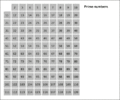mathematics, the sieve of Atkin is a modern algorithm for finding all prime numbers up to a specified integer. Compared with the ancient sieve of Eratosthenes...
14 KB (1,995 words) - 09:15, 23 May 2024
the sieve of Sundaram (1934), the still faster but more complicated sieve of Atkin (2003), and various wheel sieves are most common. A prime sieve works...
8 KB (1,154 words) - 14:51, 4 February 2024
of Atkin Sieve of Sundaram Sieve theory Horsley, Rev. Samuel, F. R. S., "Κόσκινον Ερατοσθένους or, The Sieve of Eratosthenes. Being an account of his...
24 KB (3,042 words) - 00:45, 15 August 2024
In number theory, the general number field sieve (GNFS) is the most efficient classical algorithm known for factoring integers larger than 10100. Heuristically...
13 KB (1,768 words) - 03:41, 21 July 2024
In mathematics, the sieve of Sundaram is a variant of the sieve of Eratosthenes, a simple deterministic algorithm for finding all the prime numbers up...
9 KB (1,368 words) - 04:26, 17 June 2024
Schoof–Elkies–Atkin algorithm. Together with Daniel J. Bernstein, he developed the sieve of Atkin. Atkin is also known for his work on properties of the integer...
5 KB (352 words) - 14:45, 7 September 2022
sets of numbers General number field sieve Large sieve Quadratic sieve Sieve of Atkin Sieve of Eratosthenes Sieve of Sundaram Sieve of Pritchard Sieve, in...
2 KB (334 words) - 12:50, 23 April 2024
actress Wendy Atkin (1947–2018), British professor Atkin & Low family tree, showing the relationship between some of the above Sieve of Atkin, mathematical...
1 KB (192 words) - 23:49, 27 August 2024
branch of mathematics, the special number field sieve (SNFS) is a special-purpose integer factorization algorithm. The general number field sieve (GNFS)...
9 KB (1,427 words) - 20:31, 10 March 2024
quadratic sieve algorithm (QS) is an integer factorization algorithm and, in practice, the second-fastest method known (after the general number field sieve)....
27 KB (4,487 words) - 16:24, 29 June 2024
time. The fundamental ideas of Fermat's factorization method are the basis of the quadratic sieve and general number field sieve, the best-known algorithms...
10 KB (1,443 words) - 10:57, 30 June 2024
the halfway point. Sieve of Sundaram Sieve of Atkin Sieve of Pritchard Sieve theory Pritchard, Paul, "Linear prime-number sieves: a family tree," Sci...
19 KB (3,055 words) - 08:03, 10 June 2024
theorem Brun sieve Function field sieve General number field sieve Large sieve Larger sieve Quadratic sieve Selberg sieve Sieve of Atkin Sieve of Eratosthenes...
10 KB (935 words) - 23:13, 8 August 2024
Daniel J. Bernstein (category Academic staff of the Eindhoven University of Technology)
prime sieve with low memory footprint based on the sieve of Atkin (rather than the more usual sieve of Eratosthenes). Both have been used effectively in...
21 KB (1,904 words) - 12:19, 19 August 2024
quadratic sieve and the general number field sieve (GNFS). Because these methods also have superpolynomial time growth a practical limit of n digits is...
8 KB (1,151 words) - 05:51, 16 June 2024
Prime number (redirect from Infinity of primes)
the same problem is the sieve of Atkin. In advanced mathematics, sieve theory applies similar methods to other problems. Some of the fastest modern tests...
116 KB (14,108 words) - 23:59, 15 August 2024
efficient known classical factoring algorithm, the general number field sieve, which works in sub-exponential time: O ( e 1.9 ( log N ) 1 / 3 ( log...
41 KB (5,886 words) - 09:59, 12 August 2024
Integer factorization (redirect from Factors of an integer)
completed with a highly optimized implementation of the general number field sieve run on hundreds of machines. No algorithm has been published that can...
25 KB (2,981 words) - 18:28, 21 June 2024
the rational sieve is a general algorithm for factoring integers into prime factors. It is a special case of the general number field sieve. While it is...
6 KB (915 words) - 09:57, 4 July 2024
Discrete logarithm (section Powers of 10)
However, none of them runs in polynomial time (in the number of digits in the size of the group). Baby-step giant-step Function field sieve Index calculus...
17 KB (2,043 words) - 22:45, 29 July 2024
onto the sieve (i.e., increasing the number of equations while reducing the number of variables). The third stage searches for a power s of the generator...
11 KB (1,720 words) - 04:38, 15 January 2024
algorithm by A. O. L. Atkin the same year. The algorithm was altered and improved by several collaborators subsequently, and notably by Atkin and François Morain [de]...
27 KB (4,794 words) - 18:31, 21 July 2024
divide-and-conquer algorithm that reduces the multiplication of two n-digit numbers to three multiplications of n/2-digit numbers and, by repeating this reduction...
13 KB (2,044 words) - 21:24, 21 July 2024
Primality test (redirect from Determination of primality)
giving the Sieve of Eratosthenes. One way to speed up these methods (and all the others mentioned below) is to pre-compute and store a list of all primes...
26 KB (3,806 words) - 14:19, 25 July 2024
the sieve of Pritchard. Runciman provides a functional algorithm inspired by the sieve of Pritchard. Sieve of Eratosthenes Sieve of Atkin Sieve theory...
21 KB (3,285 words) - 10:45, 2 March 2024
by p and see whether the congruence holds. If it does not hold for a value of a, then p is composite. This congruence is unlikely to hold for a random a...
8 KB (1,134 words) - 07:32, 3 June 2024
Multiplication algorithm (redirect from Computational complexity of multiplication)
the year of his death. As shown in the example, the multiplicand and multiplier are written above and to the right of a lattice, or a sieve. It is found...
47 KB (6,801 words) - 03:33, 25 July 2024
AKS primality test (section Proof of validity outline)
from sieve theory to O ~ ( log ( n ) 7.5 ) {\displaystyle {\tilde {O}}(\log(n)^{7.5})} . In 2005, Pomerance and Lenstra demonstrated a variant of AKS...
20 KB (2,448 words) - 20:19, 19 March 2024
Integer square root (section Domain of computation)
root (isqrt) of a non-negative integer n is the non-negative integer m which is the greatest integer less than or equal to the square root of n, isqrt ...
16 KB (2,410 words) - 03:37, 13 December 2023
over a modulus. It is useful in computer science, especially in the field of public-key cryptography, where it is used in both Diffie–Hellman key exchange...
21 KB (2,802 words) - 00:03, 24 March 2024






